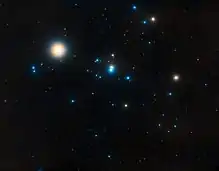HD 28527
HD 28527 is a star in the constellation Taurus, and a member of the Hyades open cluster.[8] It is faintly visible to the naked eye with an apparent visual magnitude of 4.78.[2] The distance to this star, as determined from its parallax shift of 22 mas,[1] is 148 light years. It is moving away from the Earth with a heliocentric radial velocity of +38 km/s.[2]
| Observation data Epoch J2000 Equinox J2000 | |
|---|---|
| Constellation | Taurus |
| Right ascension | 04h 30m 33.633s[1] |
| Declination | +16° 11′ 38.46″[1] |
| Apparent magnitude (V) | 4.78[2] |
| Characteristics | |
| Spectral type | A6 IV[3] or A7 V[4] |
| B−V color index | +0.170±0.001[2] |
| Variable type | suspected δ Sct[5] |
| Astrometry | |
| Radial velocity (Rv) | +38.1±0.8[2] km/s |
| Proper motion (μ) | RA: +104.422[1] mas/yr Dec.: −26.254[1] mas/yr |
| Parallax (π) | 22.0357 ± 0.2516[1] mas |
| Distance | 148 ± 2 ly (45.4 ± 0.5 pc) |
| Absolute magnitude (MV) | +1.58[6] |
| Details | |
| Mass | 1.75[7] M☉ |
| Radius | 2.209[8] R☉ |
| Luminosity | 19.03[2] L☉ |
| Surface gravity (log g) | 4.17±0.14[7] cgs |
| Temperature | 8,274±281[7] K |
| Metallicity [Fe/H] | +0.30[9] dex |
| Rotation | 1.278 d[8] |
| Rotational velocity (v sin i) | 87.5[8] km/s |
| Age | 307[7] Myr |
| Other designations | |
| Database references | |
| SIMBAD | data |

Based upon a stellar classification of A6 IV by Cowley et al. (1969),[3] this is an A-type subgiant star that has consumed the hydrogen at its core and is evolving away from the main sequence. Older studies had it classed as an A-type main-sequence star with a class of A7 V.[4] At the age of 307[7] million years, it has a high rate of spin, revolving upon its axis once every 1.278 days.[8] It is a Delta Scuti variable[5] with 1.75[7] times the mass of the Sun and 2.2[8] times the Sun's radius. The star is radiating 19[2] times the Sun's luminosity from its photosphere at an effective temperature of 8,274 K.[7]
Due to its location near the ecliptic, this star is subject to lunar occultations. These events have provided occasional, but not definitive, evidence of a close secondary companion.[11][12] Eggleton and Tokovinin (2008) catalogue this as a possible triple star system, having the inner pair being similar stars with an angular separation of 0.02″, and the outer component a magnitude 6.7 star of class F2 at a much wider separation of 250″.[13]
References
- Brown, A. G. A.; et al. (Gaia collaboration) (August 2018). "Gaia Data Release 2: Summary of the contents and survey properties". Astronomy & Astrophysics. 616. A1. arXiv:1804.09365. Bibcode:2018A&A...616A...1G. doi:10.1051/0004-6361/201833051.
- Anderson, E.; Francis, Ch. (2012), "XHIP: An extended hipparcos compilation", Astronomy Letters, 38 (5): 331, arXiv:1108.4971, Bibcode:2012AstL...38..331A, doi:10.1134/S1063773712050015.
- Cowley, A.; et al. (April 1969), "A study of the bright A stars. I. A catalogue of spectral classifications", Astronomical Journal, 74: 375–406, Bibcode:1969AJ.....74..375C, doi:10.1086/110819.
- Ljunggren, B.; Oja, T. (1961), "The Uppsala spectral classification", Uppsala Astronomical Observatory Annual, 4: 10, Bibcode:1961UppAn...4j...1L.
- Samus', N. N.; et al. (2017), "General catalogue of variable stars: Version GCVS 5.1", Astronomy Reports, 61: 80, Bibcode:2017ARep...61...80S, doi:10.1134/S1063772917010085.
- Eggen, Olin J. (July 1998), "The Age Range of Hyades Stars", The Astronomical Journal, 116 (1): 284–292, Bibcode:1998AJ....116..284E, doi:10.1086/300413.
- David, Trevor J.; Hillenbrand, Lynne A. (2015), "The Ages of Early-Type Stars: Strömgren Photometric Methods Calibrated, Validated, Tested, and Applied to Hosts and Prospective Hosts of Directly Imaged Exoplanets", The Astrophysical Journal, 804 (2): 146, arXiv:1501.03154, Bibcode:2015ApJ...804..146D, doi:10.1088/0004-637X/804/2/146.
- van Saders, Jennifer L.; Pinsonneault, Marc H. (October 2013), "Fast Star, Slow Star; Old Star, Young Star: Subgiant Rotation as a Population and Stellar Physics Diagnostic", The Astrophysical Journal, 776 (2): 20, arXiv:1306.3701, Bibcode:2013ApJ...776...67V, doi:10.1088/0004-637X/776/2/67, 67.
- Gebran, M.; et al. (November 2010), "Chemical composition of A and F dwarfs members of the Hyades open cluster", Astronomy and Astrophysics, 523: A71, arXiv:1006.5284, Bibcode:2010A&A...523A..71G, doi:10.1051/0004-6361/200913273.
- "HD 161840". SIMBAD. Centre de données astronomiques de Strasbourg. Retrieved 2018-08-06.
- Peterson, D. M.; Baron, R. L.; Dunham, E.; Mink, D.; Weekes, T. C.; Elliot, J. L. (February 1981), "Lunar occultations of the Hyades: 1979-1980", Astronomical Journal, 86: 280–289, Bibcode:1981AJ.....86..280P, doi:10.1086/112886.
- Richichi, A.; et al. (October 1999), "New binary stars discovered by lunar occultations. IV", Astronomy and Astrophysics, 350: 491–496, Bibcode:1999A&A...350..491R.
- Eggleton, P. P.; Tokovinin, A. A. (2008), "A catalogue of multiplicity among bright stellar systems", Monthly Notices of the Royal Astronomical Society, 389 (2): 869, arXiv:0806.2878, Bibcode:2008MNRAS.389..869E, doi:10.1111/j.1365-2966.2008.13596.x.
